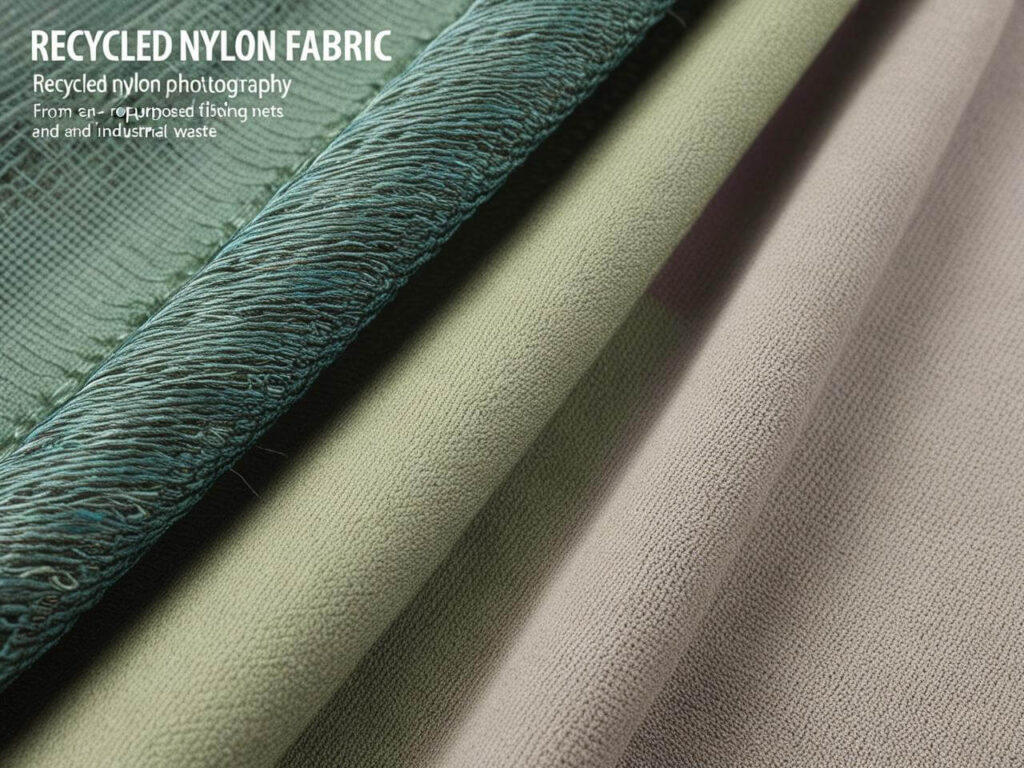Introduction
The textile industry is shifting toward sustainability, and recycled nylon fabric (rNylon) is leading the way. Made from discarded fishing nets, fabric waste, and industrial scraps, recycled nylon offers a high-performance, eco-friendly alternative to virgin nylon, reducing plastic pollution and carbon emissions.
But how does recycled nylon compare to virgin nylon, and why is it gaining popularity in sportswear, outdoor gear, and high-performance fabrics? In this guide, I’ll break down how recycled nylon is made, its benefits, and where it’s used.
What You’ll Learn in This Guide
✔ What recycled nylon fabric is and how it’s produced
✔ The key differences between recycled and virgin nylon
✔ How recycled nylon contributes to sustainability
✔ Best uses for rNylon in fashion, home textiles, and industrial applications
What is Recycled Nylon Fabric?
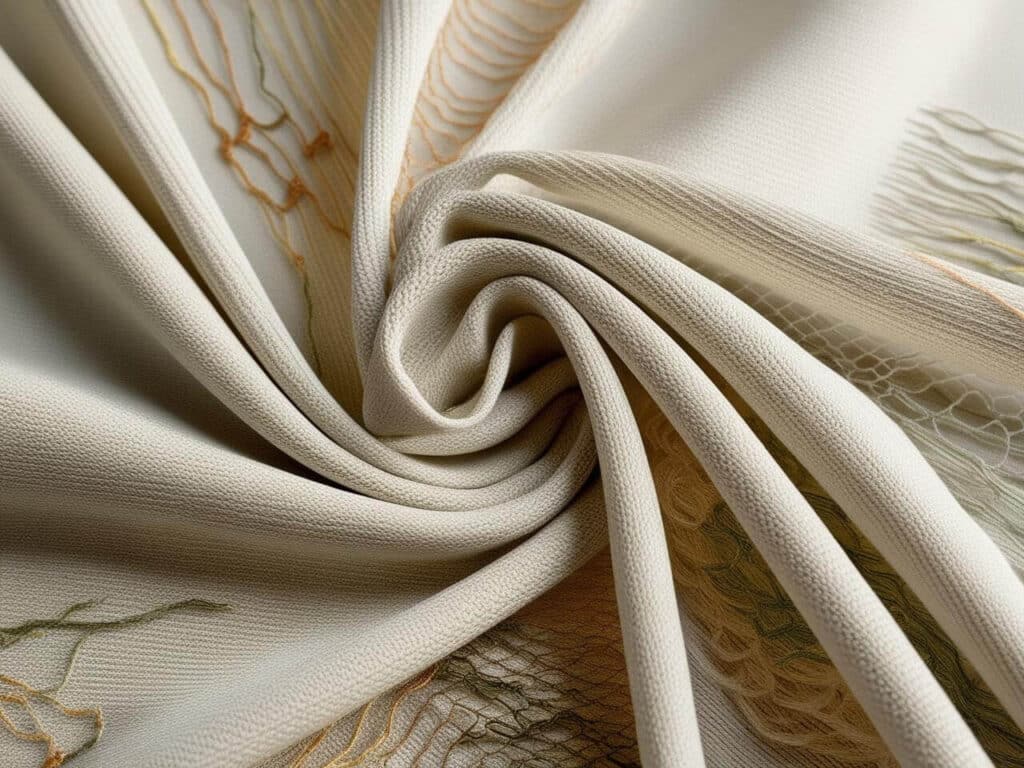
Recycled nylon fabric (rNylon) is an eco-friendly textile made from post-consumer and post-industrial waste, including discarded fishing nets, old carpets, and manufacturing scraps. This sustainable alternative to virgin nylon helps reduce plastic pollution, lower carbon emissions, and conserve resources, making it an essential material for sustainable fashion, outdoor gear, and technical textiles.
📌 Key Features of Recycled Nylon Fabric
- Made from repurposed fishing nets, fabric waste, and industrial scraps.
- Reduces plastic waste and ocean pollution by reusing discarded materials.
- Comparable to virgin nylon in durability and performance.
- Used in swimwear, sportswear, outdoor gear, upholstery, and automotive interiors.
| Feature | Description |
| Sustainability | Reduces plastic pollution, saves energy |
| Common Sources | Fishing nets, discarded nylon textiles, industrial waste |
| Durability | Strong, flexible, and abrasion-resistant |
| Water & Energy Savings | Requires fewer resources than virgin nylon |
| Best Uses | Swimwear, activewear, outerwear, technical gear |
✅ Key Advantage: rNylon helps brands and industries transition toward circular production, reducing waste and supporting environmental sustainability.
🎥 Recommended YouTube Video
📌 How Recycled Nylon Fabric is Made
🎬 A short video explaining how discarded nylon waste is transformed into sustainable recycled nylon textiles.
How is Recycled Nylon Fabric Made?
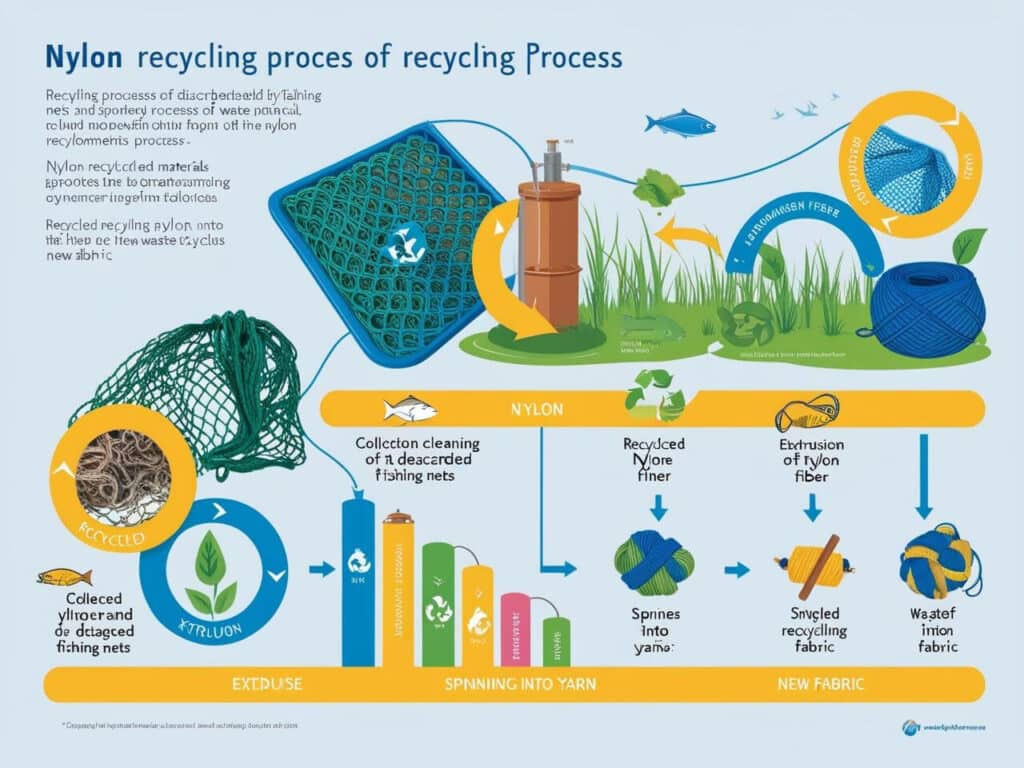
The process of creating recycled nylon (rNylon) involves repurposing discarded nylon materials, such as fishing nets, industrial fabric waste, and old carpets, into new, high-performance fibers.
📌 1. The Recycling Process
1️⃣ Collection & Sorting – Old fishing nets, nylon garments, industrial waste, and discarded carpets are collected.
2️⃣ Cleaning & Shredding – The materials are washed, purified, and shredded into small flakes to remove impurities.
3️⃣ Chemical or Mechanical Processing:
- Chemical Recycling (ECONYL® Process) – The nylon is broken down into molecular components and then re-polymerized into new high-quality fibers.
- Mechanical Recycling – The nylon fibers are melted, re-spun, and woven into fabric, though this method can slightly weaken fiber strength.
4️⃣ Spinning & Weaving – The recycled nylon fibers are processed into yarn and then woven or knitted into durable textiles.
5️⃣ Dyeing & Finishing – The fabric undergoes additional dyeing, softening, and finishing treatments for specific applications.
📌 2. Chemical vs. Mechanical Recycling
| Method | Process | Best For | Pros & Cons |
| Mechanical Recycling | Fibers are shredded and re-spun | Low-end rNylon | ♻ Lower cost but may weaken fiber strength |
| Chemical Recycling (ECONYL®) | Breaks down polymers and reprocesses them | High-quality rNylon | ♻ Produces stronger fibers, but requires more energy |
✅ Key Insight: Chemical recycling (like ECONYL®) creates premium-quality recycled nylon, while mechanical recycling is a more cost-effective but slightly lower-quality option.
🎥 Recommended YouTube Video
📌 How Recycled Nylon is Made – A Behind-the-Scenes Look
🎬 A detailed explanation of the process of turning waste nylon into sustainable fabric.
Benefits of Recycled Nylon Fabric
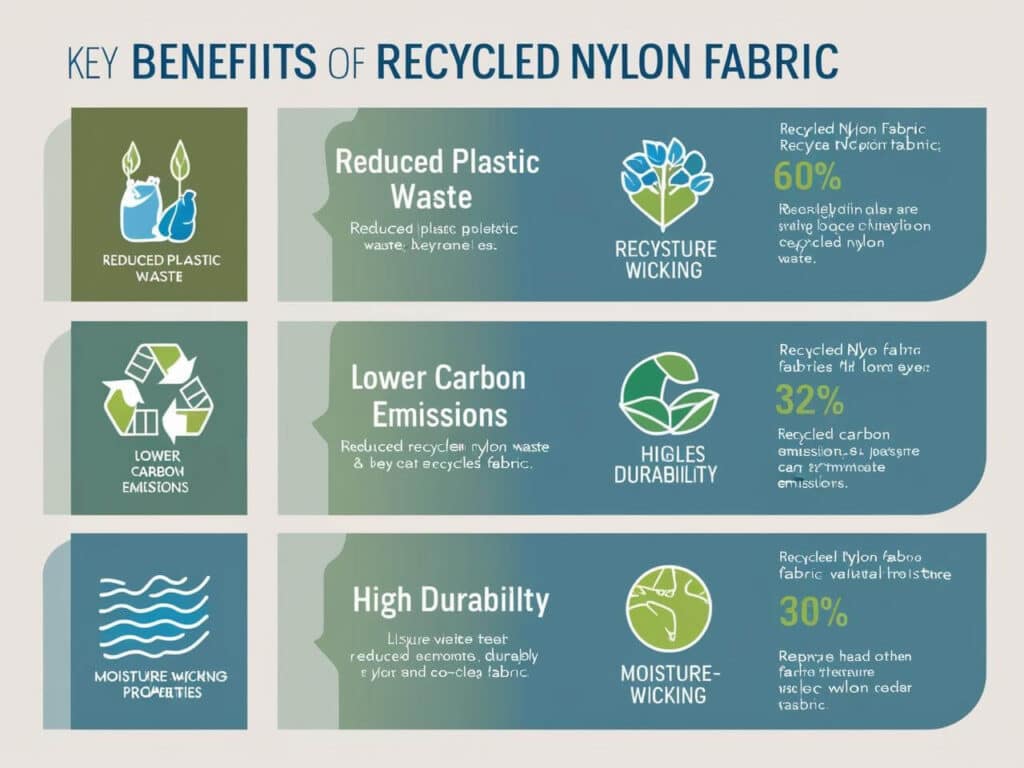
Recycled nylon (rNylon) offers significant environmental, economic, and performance advantages, making it a sustainable alternative to virgin nylon.
📌 1. Environmental Benefits
✅ Reduces Plastic & Textile Waste – Repurposes discarded fishing nets, carpets, and fabric scraps, keeping them out of landfills and oceans.
✅ Lowers Carbon Emissions – Producing rNylon generates up to 90% fewer CO₂ emissions than virgin nylon.
✅ Conserves Water & Energy – Uses less water and fossil fuel resources compared to virgin nylon production.
✅ Supports Circular Economy – Encourages textile-to-textile recycling, reducing the need for new raw materials.
📌 2. Performance & Durability
✅ Comparable to Virgin Nylon in Strength – Recycled nylon retains high durability, flexibility, and abrasion resistance.
✅ Lightweight & Moisture-Wicking – Ideal for sportswear, activewear, and technical textiles.
✅ Resistant to Shrinking & Wrinkling – Performs well after multiple washes, maintaining color vibrancy and shape.
📌 3. Versatility in Fashion & Industrial Use
✅ Used in multiple industries – Found in fashion, outdoor gear, and industrial textiles.
✅ Compatible with other fibers – Can be blended with spandex, organic cotton, or wool for added stretch and softness.
✅ Available in multiple finishes – Can be brushed, textured, or waterproof-coated for specialized applications.
🎥 Recommended YouTube Video
📌 The Benefits of Recycled Nylon Fabric
🎬 A video discussing why recycled nylon is being adopted in the fashion and textile industries.
Uses & Applications of Recycled Nylon Fabric

Recycled nylon (rNylon) is a versatile material used in fashion, outdoor gear, home textiles, and industrial applications.
📌 1. Fashion & Apparel
Sustainable fashion brands are increasingly incorporating rNylon into eco-friendly clothing and accessories.
| Garment Type | Why Recycled Nylon is Used |
| Activewear & Sportswear | Lightweight, flexible, and moisture-wicking |
| Swimwear & Surfwear | Water-resistant, quick-drying, and durable |
| Outerwear & Performance Wear | Windproof, strong, and suitable for extreme conditions |
| Luxury & Sustainable Fashion | High-end brands use rNylon for eco-conscious designs |
✅ Best for: Eco-conscious consumers looking for high-performance, sustainable fashion.
📌 2. Outdoor & Travel Gear
Thanks to its durability and water resistance, recycled nylon is widely used in travel and adventure products.
| Application | Why It’s Ideal |
| Backpacks & Travel Bags | Strong, lightweight, and water-resistant |
| Tents & Sleeping Bags | Weatherproof, windproof, and long-lasting |
| Ropes & Climbing Gear | High tensile strength and flexibility |
✅ Key Insight: Recycled nylon is favored for outdoor and travel gear due to its balance of strength and sustainability.
📌 3. Industrial & Home Textiles
Recycled nylon is also used in automotive, home decor, and industrial applications.
- Car Interiors & Seat Covers – Many automobile brands now use rNylon for upholstery and interior lining.
- Recycled Carpets & Rugs – Strong and stain-resistant, perfect for eco-friendly home design.
- Technical Fabrics & Protective Wear – Used in safety gear, military textiles, and industrial uniforms.
✅ Sustainability Impact: rNylon reduces reliance on virgin plastic materials and supports waste reduction efforts.
🎥 Recommended YouTube Video
📌 How Recycled Nylon is Used in Fashion & Technical Applications
🎬 A video showcasing the various uses of recycled nylon in fashion, travel, and industrial applications.
Recycled Nylon vs Virgin Nylon
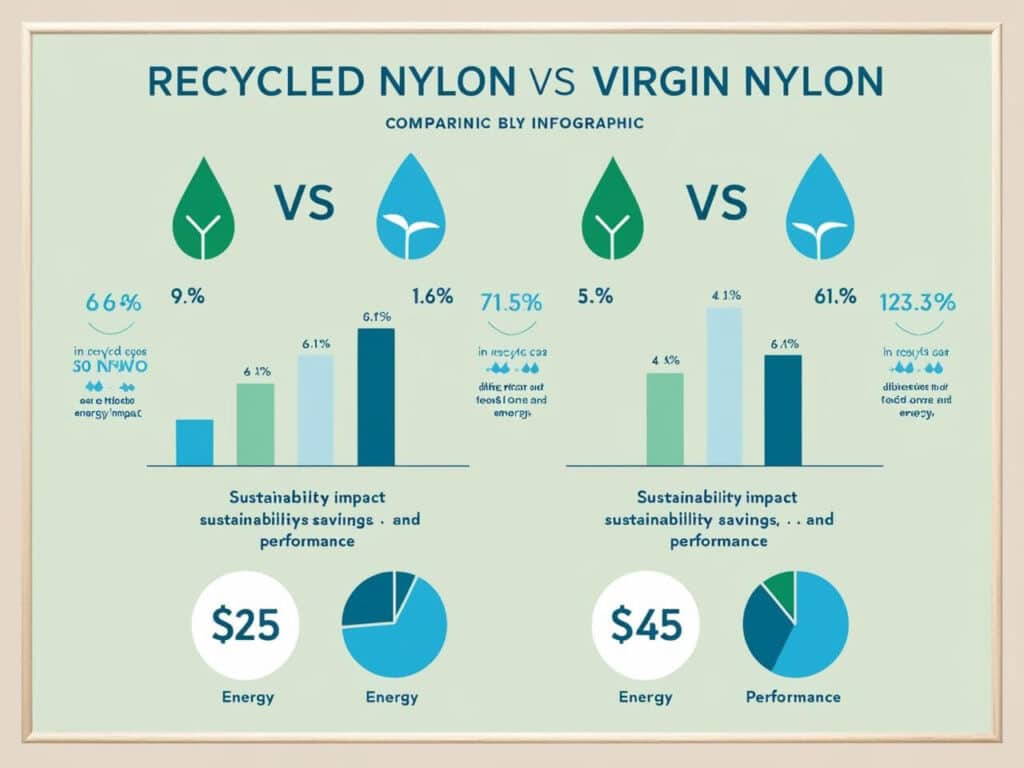
To help businesses and consumers make informed choices, let’s compare recycled nylon (rNylon) with virgin nylon in terms of sustainability, durability, and cost.
📌 1. Sustainability Comparison
| Factor | Recycled Nylon (rNylon) | Virgin Nylon |
| Environmental Impact | Low – Uses existing nylon waste, reducing plastic pollution | High – Requires petroleum-based production |
| Carbon Emissions | 90% lower CO₂ emissions than virgin nylon | High carbon footprint due to fossil fuel use |
| Water & Energy Use | Saves water and energy | High energy & water consumption |
✅ Key Takeaway: Recycled nylon significantly reduces environmental impact, making it a preferred choice for sustainability-focused industries.
📌 2. Durability & Performance
| Factor | Recycled Nylon (rNylon) | Virgin Nylon |
| Strength & Longevity | Comparable to virgin nylon, retains durability | Strong and abrasion-resistant |
| Moisture-Wicking | Quick-drying and breathable | Same as rNylon |
| Stretch & Flexibility | Good elasticity, especially in blended fabrics | Naturally stretchable and shape-retaining |
✅ Key Takeaway: High-quality recycled nylon (e.g., ECONYL®) performs as well as virgin nylon, making it suitable for demanding applications.
📌 3. Cost & Market Availability
| Factor | Recycled Nylon (rNylon) | Virgin Nylon |
| Production Cost | Slightly higher due to recycling process | Lower as virgin nylon is mass-produced |
| Market Availability | Growing demand but still less common than virgin nylon | More widely available across industries |
✅ Key Takeaway: While recycled nylon has higher production costs, the increasing market demand is making it more accessible and cost-effective over time.
🎥 Recommended YouTube Video
📌 Recycled Nylon vs. Virgin Nylon – Which is More Sustainable?
🎬 A comparison of recycled and virgin nylon, discussing their sustainability, durability, and market trends.
Pros & Cons of Recycled Nylon Fabric
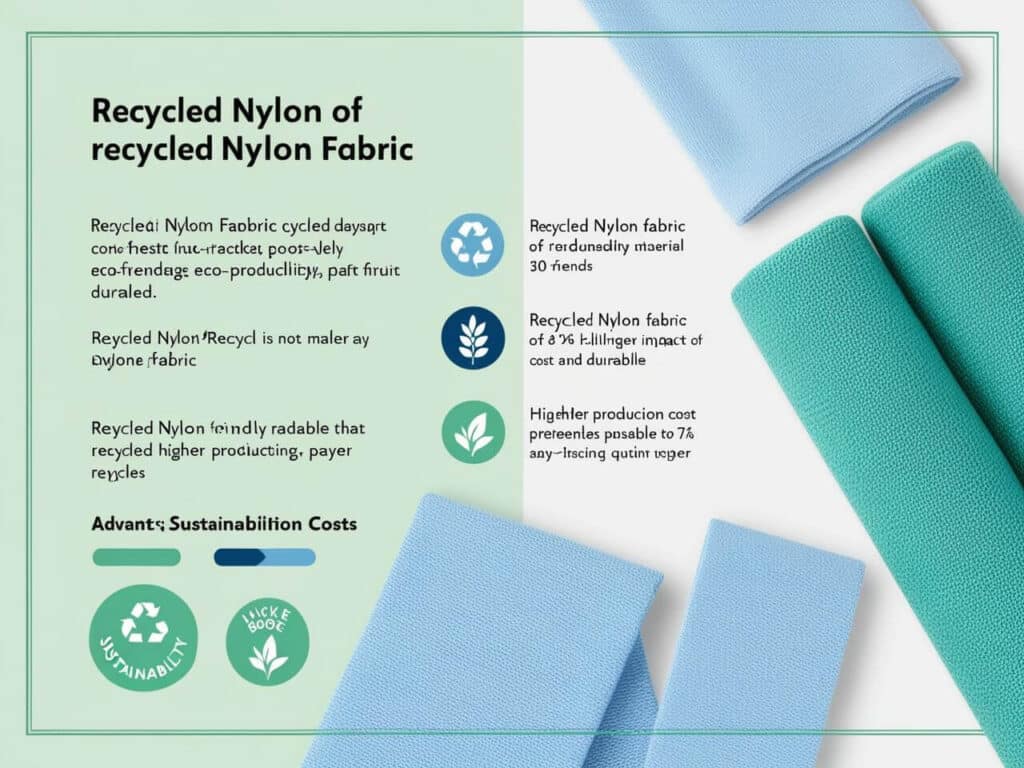
While recycled nylon (rNylon) is an eco-friendly innovation in textiles, it has both advantages and limitations. Below is a breakdown:
📌 1. Advantages of Recycled Nylon Fabric
✅ Reduces Plastic & Nylon Waste – Helps clean up discarded fishing nets, carpets, and fabric waste, reducing ocean and landfill pollution.
✅ Cuts Carbon Emissions – Producing rNylon generates up to 90% fewer CO₂ emissions than virgin nylon.
✅ Conserves Natural Resources – Uses less water, energy, and fossil fuels compared to traditional nylon.
✅ Performs as Well as Virgin Nylon – High-quality rNylon (e.g., ECONYL®) retains strength, flexibility, and durability.
✅ Supports Circular Fashion & Sustainability – Many sustainable brands use rNylon to promote eco-conscious textiles.
📌 2. Disadvantages of Recycled Nylon Fabric
❌ Higher Production Costs – Recycling requires sorting, cleaning, and reprocessing, making rNylon more expensive than virgin nylon.
❌ Potential Fiber Weakness in Some Cases – Mechanically recycled nylon may be less strong than virgin nylon.
❌ Microplastic Shedding – Like virgin nylon, recycled nylon still releases microplastics into water when washed.
❌ Limited Availability – Although demand is rising, rNylon is not as widely available as virgin nylon.
🎥 Recommended YouTube Video
📌 The Pros & Cons of Recycled Nylon Fabric – Is It Worth It?
🎬 A video analyzing the sustainability, cost, and durability of recycled nylon fabric.
FAQs: Everything You Need to Know About Recycled Nylon Fabric
To address common concerns about recycled nylon fabric, here are concise and informative answers to frequently asked questions.
❓ Is recycled nylon as durable as virgin nylon?
✔ Yes, in most cases. High-quality recycled nylon (e.g., ECONYL®) offers comparable durability and performance to virgin nylon, making it suitable for swimwear, activewear, and industrial textiles.
❓ What are the environmental benefits of recycled nylon?
✔ rNylon significantly reduces plastic waste and helps lower carbon emissions by using existing materials instead of creating new nylon from petroleum. It also conserves water and energy in the production process.
❓ Does recycled nylon shrink?
✔ Not significantly. Like virgin nylon, recycled nylon is resistant to shrinking, but it can deform slightly under high heat. It’s best to wash rNylon items in cold water and air dry them.
❓ Can recycled nylon be recycled again?
✔ Yes, but with limitations. Chemical recycling allows multiple recycling cycles, but mechanical recycling may degrade the material’s strength over time, affecting fiber quality.
❓ What is recycled nylon best used for?
✔ Most commonly used for:
- Swimwear & Activewear (quick-drying, durable)
- Outerwear & Sports Gear (strong, weather-resistant)
- Upholstery & Automotive Interiors (durable, sustainable)
- Luxury Fashion (high-quality, eco-conscious collections)
🎥 Recommended YouTube Video
📌 Recycled Nylon Fabric Explained – Common FAQs
🎬 A helpful video answering frequently asked questions about recycled nylon fabric and its sustainability benefits.
Final Thoughts: Why Recycled Nylon Fabric is a Sustainable Choice
Recycled nylon (rNylon) is a high-performance fabric that offers environmental benefits, making it a key material in the future of sustainable textiles. Whether you’re looking for eco-friendly swimwear, durable outerwear, or high-quality upholstery, rNylon combines sustainability with durability to create a greener textile industry.
✔ Key Takeaways
✅ Reduces plastic waste & ocean pollution – Helps recycle fishing nets, textile scraps, and other nylon waste.
✅ Lowers carbon footprint – Producing rNylon uses up to 90% less CO₂ emissions than virgin nylon.
✅ Durability & performance – rNylon matches virgin nylon in strength, flexibility, and resilience.
✅ Versatile applications – Used in fashion, sportswear, upholstery, and industrial products.
✅ Supports circular economy – By reusing materials, rNylon promotes recycling and reduces dependency on fossil fuels.
If you’re considering recycled nylon for your next purchase or project, it’s a sustainable, high-quality choice that aligns with eco-conscious design principles.
